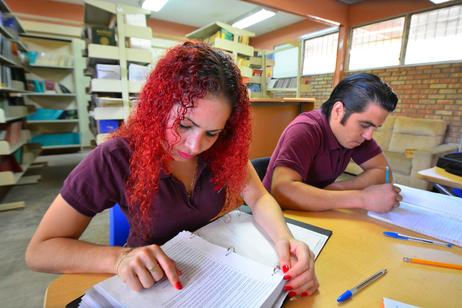The last year and a half have been difficult for all of us, but perhaps most difficult for young people who were already at a transition point in their lives. The decision to go to college is a major one even in a normal year, and one that should not be made lightly. Throwing a global pandemic into the mix complicated the situation for thousands of students, many of whom put their college plans on hold.
Now that the pandemic is slowly getting under control, experts and educators alike wonder whether we’ll see a return to normalcy in the world of academia. Thousands of students who chose to take a gap year may or may not return and, even if they did, the college experience may not be what it once was.
In this article, we’ll explore the subject of declining enrollment in the aftermath of the pandemic along with a worsening problem – the gender gap.
Community College Enrollment Pre-Pandemic
While the SARS-CoV-2 virus responsible for the COVID-19 pandemic was discovered in 2019, its global impact wasn’t truly felt until 2020. To understand the impact of the pandemic on the nation’s education system, we need to first take a look at enrollment data prior to the pandemic.
According to data from the Provisional National Center for Education Statistics (NCES), roughly 8.2 million undergraduates were enrolled in two-year public colleges for the 2018-19 school year. In the fall of 2019, 5.5 million students were enrolled – about 1.9 million full-time and 3.6 million part-time.
Students attending two-year colleges represent nearly one-third (32%) of all undergraduate students for the year, though it’s worth noting that these statistics include about 100 community colleges that offer a small number of bachelor’s degree programs which means they’re actually listed as four-year institutions. Correcting for this misclassification, the NCES suggests that 44% of undergraduates in the 2017-18 school year were community college students.
When it comes to the demographics of community college students prior to the pandemic, a significant number of Hispanic, Black, and Asian undergraduates were enrolled at community colleges. In 2018, 55% of Hispanic, 44% of Black students, and 45% of Asian students were enrolled at community college.
There were disparities in terms of gender as well. In 2019, about 57% of the community college student population was female. In that same year, less than half of new enrollees were male.
Generally speaking, young men seem less likely to enroll in college immediately following high school and, in fact, are 20% more likely than young women to drop out of college. About 57.4% of Bachelor degrees, 58.4% of Master’s degrees, and 52.8% of Doctoral degrees are earned by women. If you add the three types together, women have earned over 13 million more degrees than men since 1982.
The Impact of the Pandemic on Community College Students
The global COVID-19 pandemic left none of us untouched, but it has affected different industries and different demographics in unique and disparate ways. While thousands of prospective community college students chose to postpone their academic endeavors for another year, many didn’t. New data from a Center for Community College Student Engagement (CCCSE) report provides insight into what a pandemic-year community college experience was like. The survey was administered to 5,193 students across 38 colleges for students enrolled in the fall 2020 semester.
Here’s how the report begins:
“On the first day of the fall semester on college campuses across the country, new students are often filled with feelings of hope and anticipation for the opportunities that a college education can bring them and their families. But due to the COVID-19 pandemic, most students did not start college in the fall of 2020 surrounded by other students who were also excited for the journey they were about to collectively undertake.”
The report goes on to say that a majority of community college students only interacted with their professors, with each other, and with the campus through a computer screen. Even for the students who did take classes in person, the campus environment was significantly altered.
Here are some key data points from the survey:
- 77% of respondents said they had planned to attend the community college where they ended up going (and where they took the survey).
- 3% of respondents reported that they had been planning to attend a different school.
- 7% of respondents said they hadn’t planned to attend any college or university.
- 13% of respondents reported that they’d been planning to attend a 4-year college or university.
Given this data, the CCCSE concluded that, for the majority of community college students, the decision to attend school full-time or part-time was not impacted by the pandemic. Furthermore 75% of students didn’t end up changing their plans regarding their major, program, or pathway of study.
While the pandemic may not have impacted the plans of students who were already planning to attend community college, the CCCSE did notice some trends in data among students who either considered or did withdraw from school. Before the pandemic, 77% of students reported that lack of finances would be the driving factor in a decision to withdraw and 49% cited caring for dependents as the primary reason. Data from the report suggest that the pandemic may have exacerbated these challenges.
Interestingly, older students (aged 25 or older) reported struggling to pay for college as a result of the pandemic than traditional-age students. Unsurprisingly, non-white students reported this more often than white students.
Not only did the pandemic affect whether students could afford to attend college, but it changed the entire college experience. The majority of community colleges moved instruction online in the fall of 2020 and not all students reported having reliable internet access.
Here are some statistics:
- Almost 9 out of 10 students who took online classes reported using a computer to do so.
- 71% of students reported having reliable internet access, 25% had access but it was unreliable, and 4% had no access at home.
- About 39% of students who took online classes reported that they were all delivered in real time while 35% reported that some were and 26% said none were.
While dealing with the various challenges caused by the pandemic, many students reported not having the resources or support they needed. Students having to juggle college with work and family life have always experienced challenges, but the pandemic destroyed many of the support systems these students relied on. When asked if their school had support services to help students cope with the stress of the pandemic, only 5% said no but over half of respondents said they didn’t know.
What Does Enrollment Look Like Now?
Based on data collected through March 25, 2021, undergraduate attendance fell 5.9% compared to the same time the previous year. Overall, community college enrollment is down 4.2% from 2020. While declining enrollment is being seen across the board, it is particularly high at community colleges where there’s an 11.3% decline from last year.
This declining enrollment is noticeable across all racial and ethnic groups, though it is most pronounced in Native American students who represent a 13% decrease in enrollment from the previous year compared to 8.8% in Black students, 8.5% in white students, and 7.3% in Latino/Latina students.
Declining enrollment was visible across all age groups as well, but most pronounced in the 18-to-20-year-old age group. Perhaps surprisingly, given previous data, the demographic in which enrollment declined at a lesser pace was among men.
Examining the Gender Gap at Community Colleges
While the previous report shows a lesser decline in enrollment among male community college students during the pandemic, other data tells a different story. Data collected by the National Student Clearinghouse suggests that male enrollment fell by nearly 7% - about three times the rate of female enrollment. This gender gap is most noticeable among students of color.
In the fall of 2020, enrollment at public two-year colleges declined by 19.2% and 16.6%, respectively, among Black and Hispanic males. These numbers represent a drop of more than 10 percentage points over their female counterparts. Decline in enrollment among Asian men was less significant, but still a stark difference from the decline in Asian women (about 8 times higher).
The decline in male enrollment at community colleges doesn’t just spell trouble for diversity on campus. It means less revenue for colleges and fewer workers to fill an increasing number of jobs that require at least some degree of college education. This could lead to a workforce that is even more split along gender lines in the future.
Why Are Men Underrepresented in Higher Education?
While it is difficult to determine exactly what has caused this gender gap to develop, there are some theories. These theories call into play educational, social, and demographic factors. Jim Shelley, the manager of Men’s Resource Center at Lakeland Community College in Ohio, suggests the “anti-school, anti-education sentiment” in boys starts as early as kindergarten.
One theory suggests that young men may be underprepared for college in comparison to young women. Boys and girls display different rates of cognitive development and the development of self-regulatory behaviors. In recent years, many schools have begun to emphasize reading and writing skills, skills in which girls tend to excel over boys, which can lead boys discouraged and disinterested in school. There is also some concern that many schools fail to sufficiently attend to the needs of particularly active or inquisitive students, either male or female.
Another theory is related to the decline in educational aspirations among men that has been noticeable since the 1990s. At this point in time, women more often expressed intentions to attend college than men – a difference that was noticeable among both low-income and middle-income students.
Jerlando Jackson, director and chief research scientist at Wisconsin’s Equity and Inclusion Laboratory at the University of Wisconsin, says, “Many boys beyond [eighth or ninth grade] perceive little benefit to college, especially considering its cost.” Jackson suggests that, for some young men, going to college represents a major sacrifice with a vague payoff somewhere far in the future. This ideology seems most common among low-income boys – one study referred to it as the “economic despair of seeing little hope for future advancement.”
Some experts suggest men simply feel they have more alternatives to college than girls. Instead of attending a four-year university, many attend 18-month vocational programs and end up making just as much money.
What Are Colleges Doing to Attract More Men?
Half a century ago, in the 1970s, men and women attended college in roughly equal numbers. Today, however, women account for about 57% of total enrollment and experts are uncertain in providing explanations for the shift. Some suggest that girls tend to perform better in primary and secondary school than boys and that boys may face increased pressure to join the workforce.
Thomas A. DiPrete, a professor of sociology at Columbia University and the co-author of The Rise of Women: The Growing Gender Gap in Education and What It Means for American Schools, suggests the disparity may be related to a history of discrimination in the job market.
DiPrete says, “Up until the 1960s, many of the jobs that required a college degree were essentially closed to white women and people of color in general. Women of all races still went to college to become nurses and teachers, but Black men didn’t have the same incentives to get college degrees that white men had.”
In an effort to attract more male students, many community colleges are adding sports teams and majors that appeal more to men than women. Programs in criminal justice and information science are particularly attractive to male students. Some schools are also developing mentorship programs for men, particularly Hispanic and Black male students.
Some addition steps academic institutions can take to help reduce the gender gap, as suggested by Inside Higher Ed, may include:
- Providing resources and programs to help young men develop communication, critical reading, and collaboration skills needed in the modern service economy.
- Tailoring degree programs to make them more relevant and engaging – expanding experiential learning opportunities and entrepreneurship programs.
- Placing a grater emphasis on mentorship and mentored activities.
- Providing support services relevant to the challenges young men face – such as issues of consent in relationships.
- Being more transparent about costs, course requirements, and the benefits of specific degree programs offered by the school.
Though it remains unclear how best to address the growing gender gap, one thing remains clear – we can’t ignore it. Failure to acknowledge or address declining enrollment and widening gender gaps could be a death sentence for community colleges. Some admissions officers fear that if the percentage of female students exceeds 60%, enrollment will fall for women as well as men.
Most Popular Degrees by Gender
To bring this subject to a close, let’s take a look at some of the most popular college degree programs and see how they compare in enrollment among men and women.
Here’s a list of the top 10 Bachelor’s degrees for men in 2016:
- Business Administration and Management
- Accounting
- Biology/Biological Sciences
- Finance
- Mechanical Engineering
- Psychology
- Economics
- Political Science and Government
- Marketing/Marketing Management
- Registered Nursing
If you take a look at the top 10 Bachelor’s degrees for women in the same year, you’ll see it is almost reversed. Some of the same degrees appear on both lists, but in very different positions.
Here are the top 10 Bachelor’s degrees for women in 2016:
- Registered Nursing
- Psychology
- Business Administration and Management
- Biology/Biological Sciences
- Accounting
- English Language and Literature
- Elementary Education and Teaching
- Multi-Interdisciplinary Studies
- Speech Communication and Rhetoric
- Social Work
There’s been a noticeable shift from the humanities to occupational majors in recent years, especially among women. Business is one of the most popular college majors across the board with nearly 1 out of 5 graduates receiving a business degree – nearly half of them are earned by women. Women also continue to dominate the field of nursing and teaching, though men in those fields tend to earn more than women. In government public health jobs, women make $3,000 less than men on average.
The field of education is in constant flux, even without a global pandemic driving change. If community colleges hope to survive, they will have to acknowledge their shortcomings and adapt to the changes. Stay tuned for more updates on the impact of the COVID-19 pandemic on the education industry.












